Question Types Available
The following question types are available:
See Also: Adding Questions to a Test
Calculated Formula questions present students with a question that requires them to make a calculation and respond with a numeric answer. The numbers in the question change with each student and are pulled from a range that you set. The correct answer is a specific value or a range of values. You may grant partial credit for answers that fall within a range. Calculated Formula questions are graded automatically.
More on partial credit.
In the example, the numbers 6 and 9 are randomly generated from a range of values set by an instructor.

An instructor created this question:
If a small glass can hold [x] ounces of water, and a large glass can hold [y] ounces of water, what is the total number of ounces in 4 large and 3 small glasses of water?
When a student views the question, the variables [x] and [y] are replaced with values that are generated randomly from number ranges that the instructor specifies.
See Create a Calculated Formula Question tutorial to learn more.
With Calculated Numeric questions, students are presented with a question that requires a numeric answer. The question doesn't need to be a mathematical formula. You can provide a text question that requires a numeric answer. Calculated Numeric questions resemble Fill in the Blank questions where correct answers are numbers.
- Students may enter a number as an answer. The number can be an integer, decimal, or scientific notation. The largest value supported is 16 digits.
- Instructors may combine text and mathematical formulas in the question.
- Instructors may define an answer range. The range value can be an integer, decimal, or scientific notation. The largest value supported is 16 digits.
- The answer field validates only numeric digits.
Example:
If the average human body temperature under normal conditions ranges between 36.5 and 37.5 degrees Celsius, what is the average human body temperature in degrees Fahrenheit?
You can specify an exact numeric answer, or you can specify an answer and an allowable range.
Calculated Numeric questions are graded automatically.
NOTE: Calculated numeric answers must be numeric, not alphanumeric—42, not forty-two.
See Create a Calculated Numeric Question tutorial to learn more.
Essay questions require students to type an answer in a text box, and you need to grade these questions manually.
When you create a new test, select the plus sign to open the menu and select Add Essay question.
You'll use the same process when you create questions in tests and assignments.

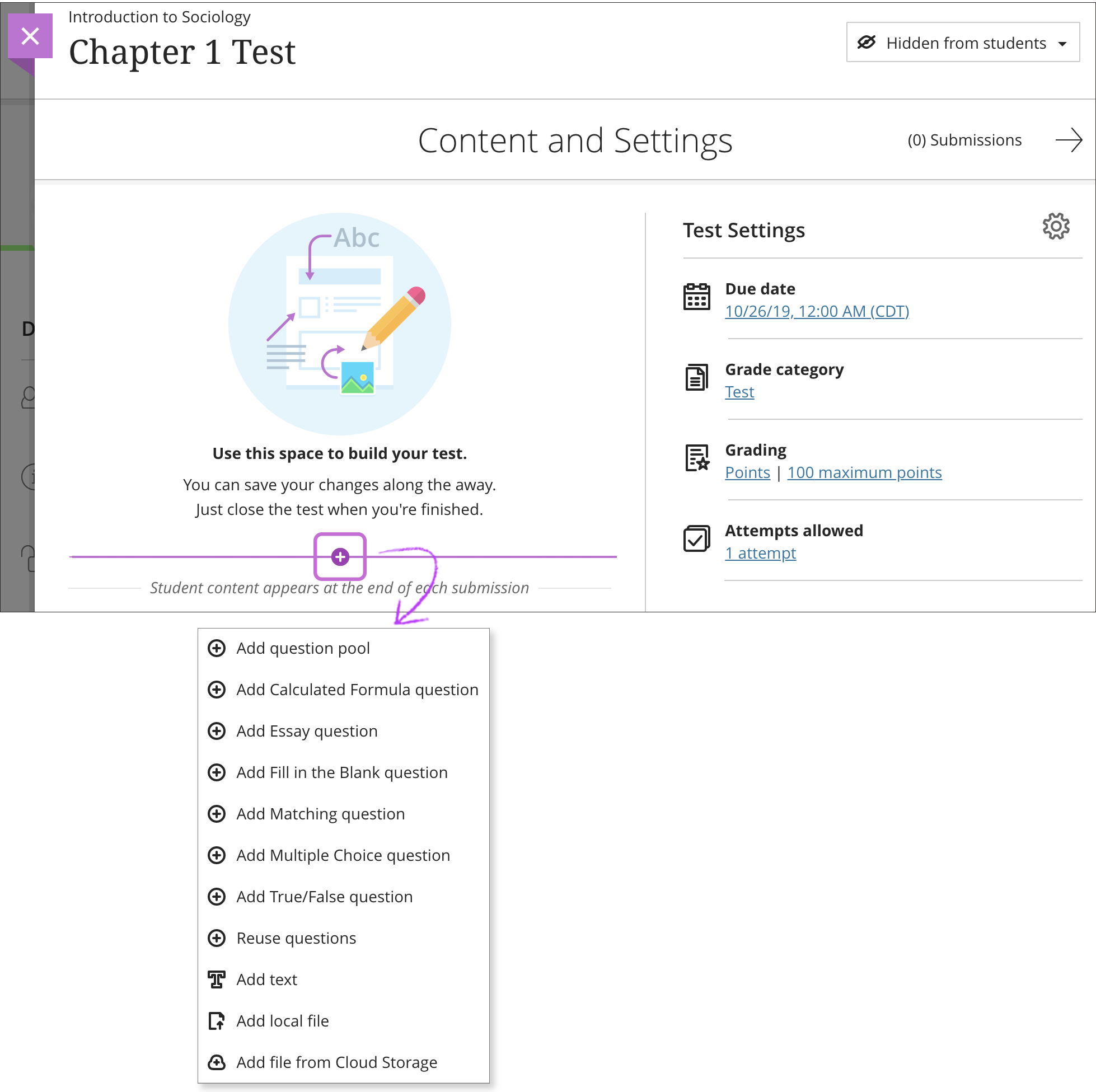
The Test Content area opens where you create the Essay question. Questions have a default value of 10 points. Select the Points box to type a new value.
To help keep your test content organized, you can add files within individual questions. Make a selection from the editor's Insert Content menu, such as Insert from Cloud Storage. To edit the files you added, enter edit mode for the question.
A Fill in the Blank question consists of a phrase, sentence, or paragraph with a blank space where a student provides the missing word or words. You can also create a question with multiple blanks.
Example:
[Patriarchy] translates to "rule by the father."

Fill in the Blank questions are graded automatically. Answers are scored based on if student answers match the correct answers you provide. You choose the evaluation method for answers:
- Exact match
- Contains part of the correct answer
- Matches a pattern that you specify
You choose whether or not the answers are case-sensitive.
Answers need to be accurate (exact match) or chosen to match a pattern and be defined accordingly. See Create a Fill in the Blank Question tutorial to learn more.
Use the Fill in the Blank question type to create a question with multiple blanks. For Fill in Multiple Blanks questions, students view text that contains multiple blanks. Students type the appropriate word or phrase for each blank.
Example:
"Four [score] and [seven;7] years ago" is the beginning of the [Gettysburg Address] delivered by [Lincoln]."
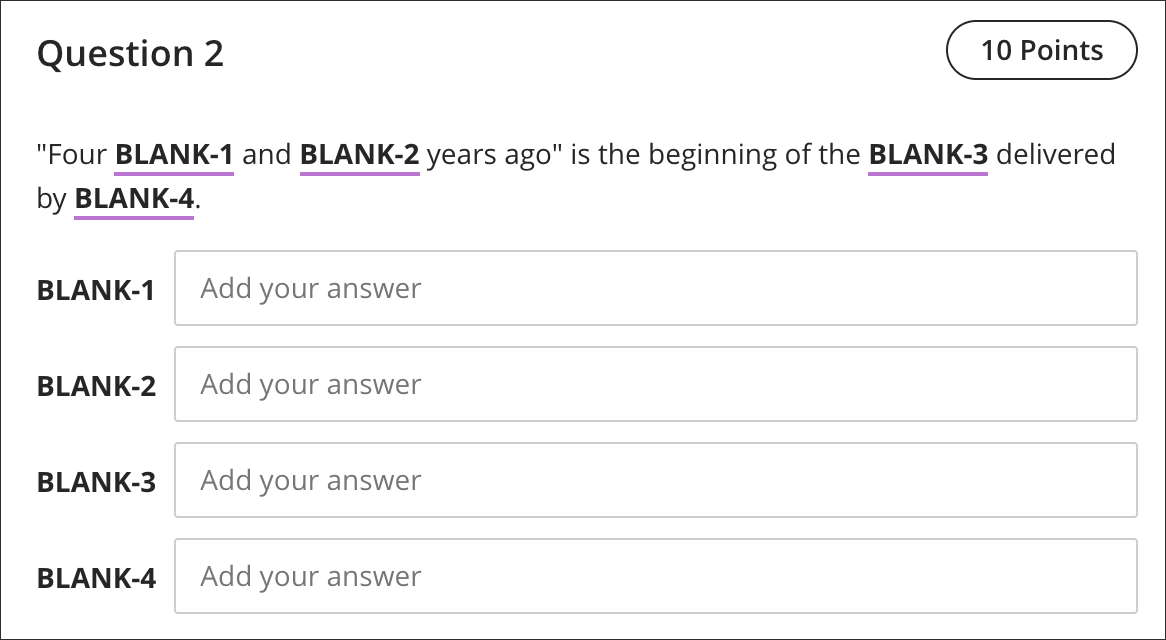
With Hot Spot questions, students are presented with an image and select a particular area as the answer. Examples of Hot Spot questions include these:

- Anatomy: Locate parts of the body.
- Geography: Locate areas on a map.
- Foreign Language: Select articles of clothing.
Hot Spot questions are graded automatically.
Have the image file ready before you create the question. You can upload the image file from your computer or link to it from Course Files or the Content Collection. Accepted image files include GIF, JIF, JPG, JPEG, PNG, TIFF, and WMF.
Although no limitations exist, consider the size of the image and make adjustments with an image editing application before you upload the file.
See this Hotspot Question Creation tutorial to learn more.
Instructors can create jumbled sentence questions that lets instructors define one or more paragraphs with blanks for students to complete. Additionally, instructors can:
- Define distractors to challenge students (distractors are answer options that "distract" from the correct answer)
- Add automated feedback for correct and incorrect answers
- Designate questions as extra credit
- Use accessibility tools, such as keyboard-only workflows, to create this question type
To create a variable, insert the variable in square brackets within the paragraph. Each variable is automatically recognized as the correct answer. Instructors can enable partial credit to award points for partially correct responses. For example, if half of the answers are correct, half of the max points are awarded.
Variables can include the following characters:
- Letters
- Digits (0-9)
- Periods (.)
- Underscores (_)
- Hyphens (-)
The question text and variable input are validated for syntax correctness, notifying instructors of any errors, such as a missing bracket.
Example paragraph with variables:
Single water molecules are held together by [covalent] bonds and multiple water molecules are held together by [hydrogen] bonds. The kind of bond where atoms are sharing electrons but are not sharing them equally is [polar covalent bond].
Saved questions display variables in bold and underlined in purple for clarity. Instructors can also manually add feedback to student responses and use the Edit/Regrade workflow during grading.
Image 1: Instructor creates a jumbled sentence question type.

Student View of Jumbled Question Type
Answer options are displayed in a random order, ensuring fairness in the assessment experience.
Students can:
- Identify if a question is marked as extra credit
- Answer questions using assistive technology
- Auto-save their responses as they work
- Reset the question to clear all selections
With Matching questions, students pair items in the prompts column to items in the answers column. The number of items in each column doesn’t have to be equal because you can reuse answers and add additional answers. Additional answers are distractors that don’t match any of the prompts and increase the question's difficulty. Some instructors use distractors so students can’t guess at answers by the process of elimination.
Example:
Match the animals to their diets.
Students match the prompts: pig, lion, zebra, horse, and hedgehog to the answers: carnivore, omnivore, and herbivore.
In this example, students need to use some answers more than once. All answers appear in a random order to students.

See this Matching Question Creation tutorial to learn more.
Multiple Answer questions are graded automatically. If an assessment only has these types of questions, the assessment scores are posted automatically for students to view.
You'll use the same process to create Multiple Choice and Multiple Answer questions in tests and assignments.
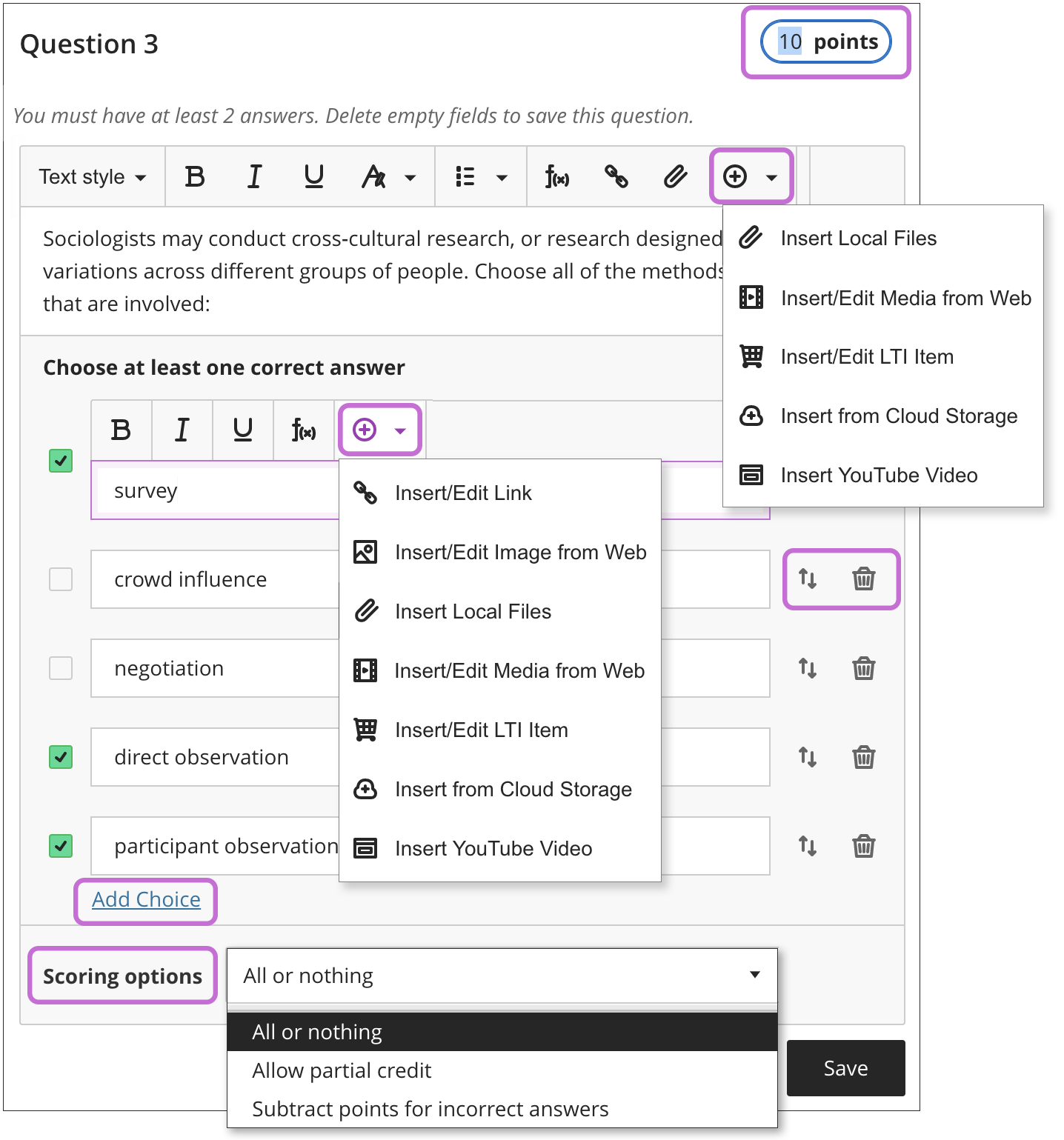
To create Multiple Answer questions, use the Multiple Choice question type and choose multiple correct answers. You can allow partial credit and negative credit for answers.
New questions don't have a default correct answer. You can't save unless you select at least one correct answer and add text for all your answers.
Questions have a default value of 10 points. Select the Points box to type a new value. If you want more than four answer boxes, select Add Choice. You can add as many answer boxes as you need. Select the Move icon to move an answer. Select the trash can icon to delete an answer. Delete any empty fields to enable the Save option.
Multi-select questions require students to select multiple correct answers from a list. This variation of a multiple-choice question encourages critical thinking. Some instructors may award partial credit to students on these types of questions. Partial credit promotes a fairer and more accurate assessment of students' knowledge. Negative credit auto-distributes across wrong answer choices. An instructor can remove or edit the negative credit if desired.
When you create a new test, select the purple plus sign to open the menu. In an existing test, select the purple plus sign wherever you want to add a question. Select Add Multiple Choice question. You'll use the same process when you create questions in tests and assignments.
With Multiple Choice questions, students select one or more correct answers from several choices. Students aren't told if they need to choose one or multiple answers. You can only randomize answers for Matching and Multiple Choice questions.
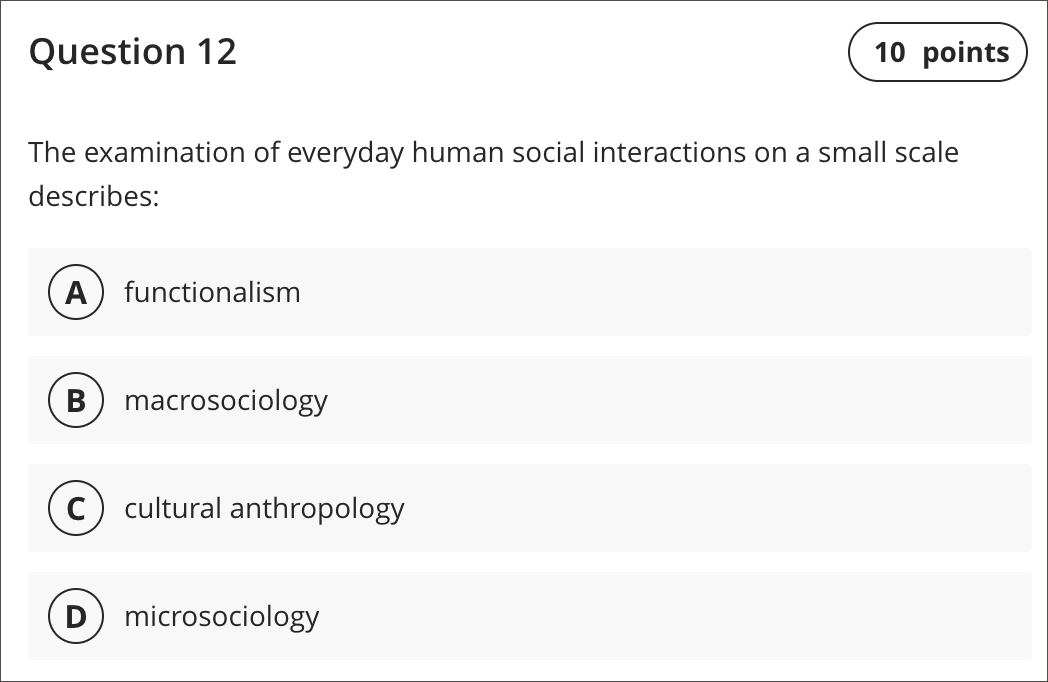
Multiple Choice and Multiple Answer questions are graded automatically. If you include multiple correct answers for a question, you can choose to give partial or negative credit.

The Test Content area opens where you create the question and answers. Questions have a default value of 10 points. Select the Points box to type a new value.
New Multiple Choice questions don't have a default correct answer. You can't save unless you select at least one correct answer and add text for all your answers.
To help keep your test content organized, you can add files within individual questions. Make a selection from the editor's Insert Content menu, such as Insert from Cloud Storage. To edit the files you added, enter edit mode for the question.
Next to the four default answer boxes, you can delete answer boxes you don't need. If you want more than four answer boxes, select Add Choice. You can add as many answer boxes as you need. Select the Move icon to move an answer. Select the trash can icon to delete an answer.
Each Multiple Choice question must have at least two answer choices and one or more correct answers. Delete any empty fields to enable the Save option.
The True/False question type only allows True or False answers. Use the Multiple Choice question type to use other binary answer sets such as Yes/No, Agree/Disagree, or another combination of answer choices.
When you create a new test, select the plus sign to open the menu. In an existing test, select the plus sign wherever you want to add a question. Select Add True/False question.
You'll use the same process when you create questions in tests and assignments.
With True/False questions, students choose true or false in response to a statement question. True/False questions are graded automatically. You can't change the points an individual student earned for an automatically graded question.


The Test Content area opens where you create the question and select True or False as the correct answer. Questions have a default value of 10 points. Select the Points box to type a new value.
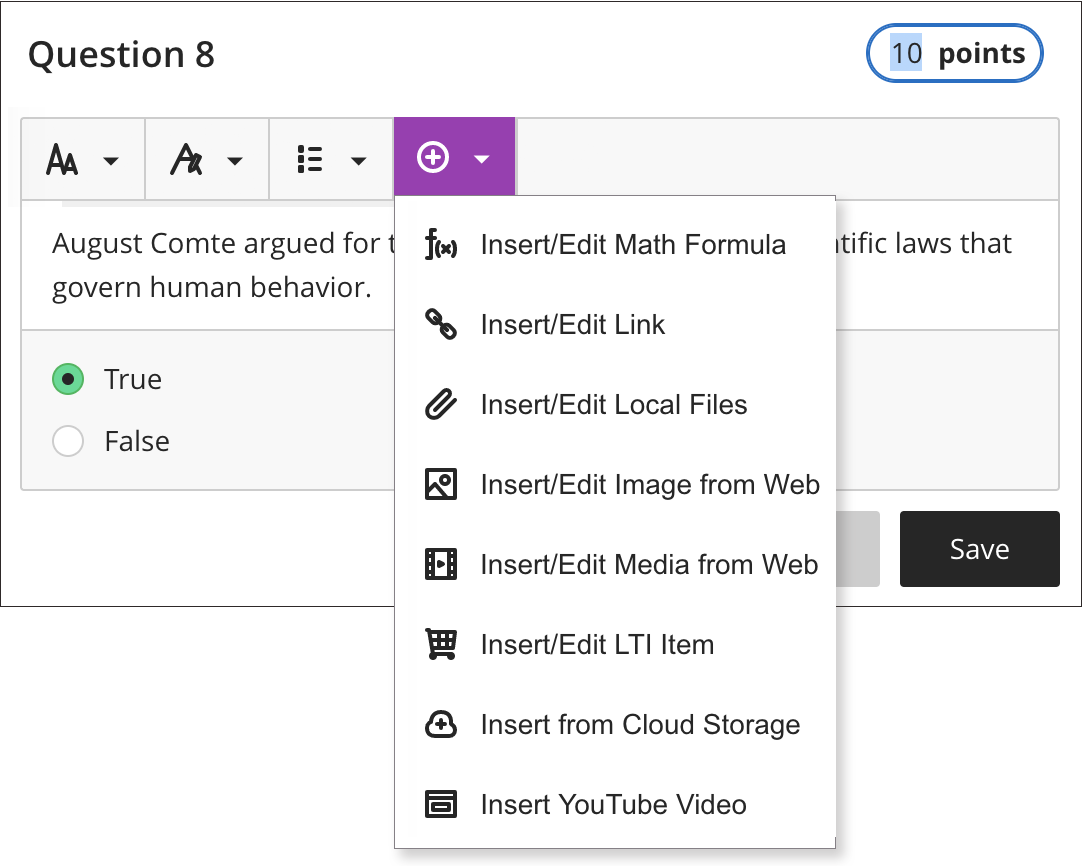
You can use the options in the editor to format the text.
To help keep your test content organized, you can add files within individual questions. Make a selection from the editor's Insert Content menu, such as Insert from Cloud Storage. To edit the files you added, enter edit mode for the question.